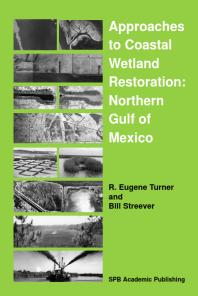(Ebook) Approaches to Coastal Wetland Restoration : Northern Gulf of Mexico by E.R. Turner; B. Streever ISBN 9789062997961, 9062997961
Wetlands Lost The 1,879 thousand hectares of coastal wetlands in the Gulf of Mexico (GOM) comprise 58% of the U.S. coastal wetland total (Turner and Gosselink 1975). These wetlands occur in every GOM state, although two-thirds of the GOM total are in Louisiana, and are typically associated with estuaries, bays, rivers, and the lee-side of barrier islands. The objective of this book is to facilitate and encourage the restoration of these and other wetlands by reviewing the details of construction and costs (which can range from $1 to $45,000 per hectare), and by evaluating case studies for levels of success. Each approach is presented in brief chapters outlining the essential points of "what, why, and how" the approach can be planned and implemented. The driving purpose, or goal, of this book is to accelerate regional wetland gains and to promote cost-effective practices in wetland restoration. Why do we think that this book is necessary? The area of wetlands has been diminishing almost everywhere for the last several hundred years, but particularly this century, as the twin juggernauts of population growth and per capita resource exploitation expanded. In 1927, as the Great Depression in the U.S. was about to start, there were 2 billion people on the planet. There were 6 billion people on the Earth in the year 2000 and by 2054 there will be 9 billion. Two hundred years ago there were 89.5 million ha of wetlands in the contiguous 48 U.S. states (Dahl 1990). By 1997 this area had shrunk to 42.7 million ha (Dahl 2001). From the 1970s to the mid-1980s, the annual wetland loss rate was 117,400 ha (Dahl and Johnson 1991). The official national policy of "no net loss" may be why the wetland loss rate slowed to 23.7 thousand ha yr-1 from 1986 to 1997 (Dahl 2001). Although wetland loss rates have also declined in coastal Louisiana in recent years, Louisiana experienced particularly high coastal wetland loss rates of 12.5 thousand ha yr-1 (0.86% yr-1) from 1956 to 1978 (Baumann and Turner 1990). Thus, wetland loss has become a national concern (National Research Council 1991; Dahl 2001, National Research Council 2001) and particularly in the northern Gulf of Mexico. We hope to contribute to the reversal of these wetland losses by presenting wetland restoration and creation approaches appropriate for the Northern Gulf of Mexico, and perhaps elsewhere.
*Free conversion of into popular formats such as PDF, DOCX, DOC, AZW, EPUB, and MOBI after payment.


